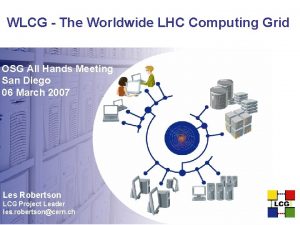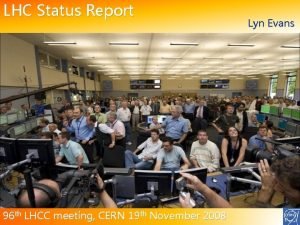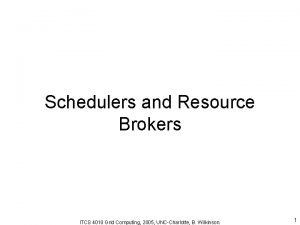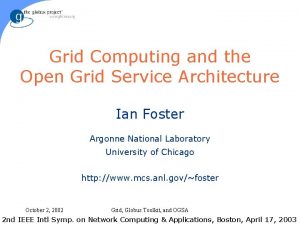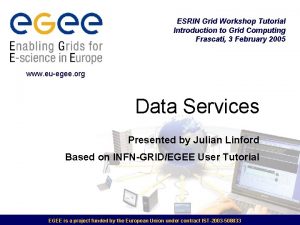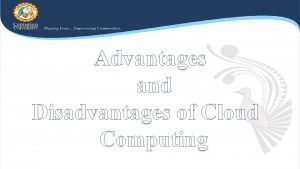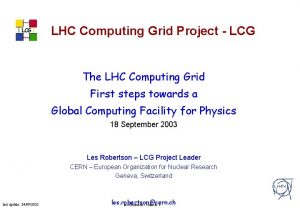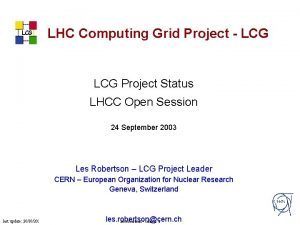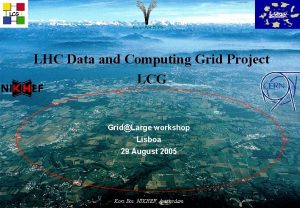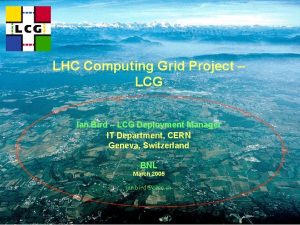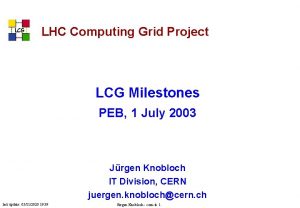LCG LHC Computing Grid Project LCG LHCC Comprehensive








- Slides: 8

LCG LHC Computing Grid Project – LCG LHCC Comprehensive Review of actions taken in response to last year's review Les Robertson 22 -23 November 2004 CERN – European Organisation for Nuclear Research Geneva, Switzerland les. robertson@cern. ch

LCG § § § 26 October 2004 Management & General Concern over resources in Regional Centres - Mo. U should be developed over the next 12 months between the funding agencies and CERN § Draft Mo. U presented to the C-RRB October 2004 § Planning group has assembled Tier-1 centre resource plans for Phase 2 LHCC expressed some reservation on the role and composition of the new SC 2 and these issues must be re-visited. § New internal review process established. ¨ Analysis of the quarterly report. System of god-parents assigned to each area. View of area managers is that this is more constructive and useful than the previous system. ¨ Annual in-depth discussion on each area – with a view to the future as well as the past. Propose a new set of Level 1 milestones for the March meeting § Done 2

LCG Middleware (i) § Concern that the existing middleware is generally too complex and underdeveloped, and from past experience the main risk appears to be the lack of product delivery. § The current middleware package (LCG-2) has been stabilised during the data challenges of 2004. The first level support is provided by the CERN Grid Deployment Group and the Wisconsin VDT team. There agreements with some of the original developers in order to have access to in-depth expertise as necessary. § The strategy is to continue to provide support for this set of middleware, until it can be replaced by improved products coming from the EGEE g. Lite activity. § Limited effort (~2 FTEs) is available in the Grid Deployment Group to provide short term improvements to LCG-2. This has been used to respond to performance and functionality problems in data management (catalogue, light -weight disk pool manager, reliable file transfer service). § Concern over the difficulties in entering the analysis phase of the project – expecting the ARDA project to have been planned by end January. § Following an ARDA workshop in January, the outline of the project was agreed on 12 February, and work started in April. The project aims at prototyping analysis systems for each experiment. Since May the project has been able to work with initial prototypes from the EGEE (g. Lite) project. 26 October 2004 3

Middleware (ii) LCG § The LHCC considers it very important for the middleware project to ensure tight links and collaboration with the US part of the effort and to establish a close and better collaboration with all the Regional Centres. § A close relationship has been established between the current middleware support team in the GDA and VDT, with some funding coming from NSF. The aim is to provide support for VDT components in the LCG-2 distribution. § Several initiatives to seek closer compatibility between Grid 3 -OSG – joint security group, synchronised information service (goal of cross-grid job submission), and (following LCG Operations Workshop) on operations. This is being followed by the Grid Deployment Area steering group. § The EGEE g. Lite middleware team includes Miron Livny, leader of the VDT project, and people from the Globus project (ANL and ISI/USC). Dane Skow(FNAL) also participates on security issues. There also contacts with other key US experts including Bob Cowles, Ian Foster and Carl Kesselman. § The Open Science Grid initiative uses the g. Lite Architecture/Design Document as a reference in their Architecture team. § The strategy is to aim for compatibility between the Tier 1 centres 26 October 2004 4

Fabric LCG § 26 October 2004 No concerns or recommendations 5

LCG § § § 26 October 2004 Grid Deployment Concern over resources and priorities in Regional Centres. The Committee recommends that the Regional Centres should be queried on how they believe funds will become available to achieve their required computing capacity. § The Phase 2 Planning Group has completed a first round with the major Regional Centres, assembling planning data. . § The Mo. U will provide a formal basis for funding agencies and regional centres to commit to these plans. The GDB should ensure that there is more detailed technical discussion. § The Grid Deployment Area set up a weekly coordination meeting to enable improved technical discussion between all the parties involved in deploying, operating and using the service. § The GDB has taken up overall coordination of the service challenges. § A standing working group on fabric management is being established by the GDA. Installation is too complex. § In the LCG-2 release, the installation of the worker nodes of the batch farms is now much simpler and does not rely on any particular tool. The success of this is indicated by the very rapid ramp-up in the number of centres installing the package 6

LCG § § 26 October 2004 Applications Concern over the long-term continuity of personnel, and the long-term support of products, in particular the maths library. § The problem of Phase 1 -Phase 2 staffing at CERN has been taken up by the CERN management. It is hoped that this will be resolved during the next two months. § The long-term support plan, scheduled for the end of 2004, has been postponed to the end of the first quarter of 2005. . Stresses the importance to support the Monte Carlo generator codes required by the LHC experiments. Such support appears to fit the scope of the Simulation project. § Improved support for MC generators implemented, largely following the conclusions of the Review of Generator Services Subgroup of LCG that took place on 25 March. 7

Applications (ii) LCG § 26 October 2004 Requests further clarification of how proposals made in the Architect’s Forum are to be incorporated in to the Applications Area. § For proposals in areas already within the scope of the applications area, the Architects Forum (AF) acts as the decision making body, subject to PEB endorsement of significant decisions, particularly those requiring future allocation of resources. Issues where agreement cannot be reached in the AF are taken to the PEB. § For proposals in areas outside the present scope of the applications area, applications area projects develop proposals, present them to the AF for modification and approval, and the AFagreed proposal is presented to the PEB for a decision. § For proposals within AA scope but for which the AF is unable to reach agreement, a policy has been in place from the beginning to escalate the issue to higher management (now the PEB) for resolution and decision. To date, this course has not had to be invoked. § After each meeting of the Architects’ Forum, a summary of the conclusions and decisions is presented to the PEB. 8
